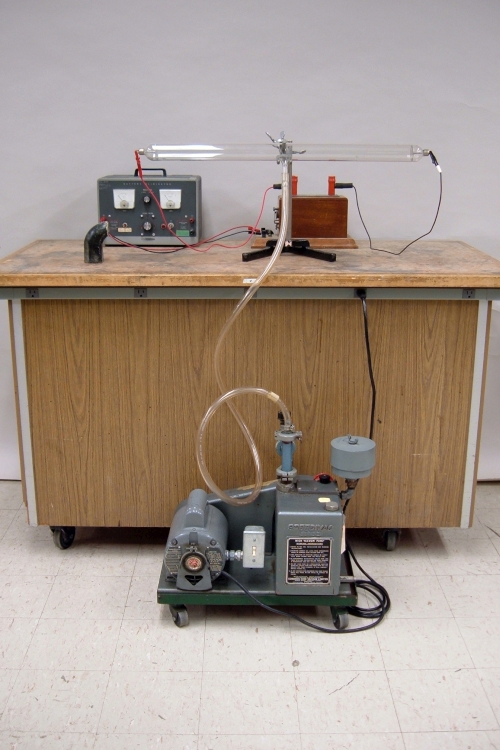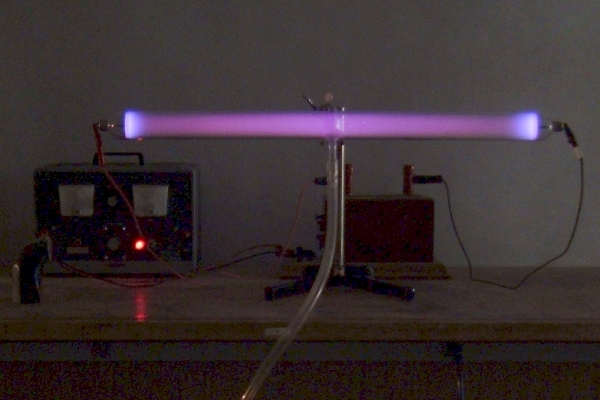 |
 |
 |
 |
An induction coil, whose primary operates at six volts, provides pulsating high voltage across the ends of a discharge tube, at each end of which is a circular plate having a diameter roughly equal to the i.d. of the tube. The distance between the electrodes is about 71.5 cm, and the tube i.d. is about 4.5 cm. You can evacuate the tube by connecting a vacuum pump to the side arm in the center of the tube.
With the tube at atmospheric pressure, when you turn on the induction coil, its output voltage is not high enough to achieve breakdown. When you turn the pump on and begin evacuating the tube, when the pressure gets to several tens of torr, you see thin, intense ribbons spanning the space between the electrodes. These then coalesce into a broader, single ribbon. Then, the entire space between the electrodes lights up. Eventually, striations appear in the middle section. If you pump for several minutes, the middle third, or so, of the tube darkens relative to the ends. The glowing gas that fills the tube is a plasma, which you can deflect in various ways with the magnet shown in the photograph.
This demonstration shows a type of electrical discharge through a gas, called glow discharge. Demonstrations 56.32 -- Wimshurst machines, 56.45 -- Sparks with the Van de Graaff generator, 56.54 -- Lightning rod and 60.06 -- Jacob’s ladder all involve a similar phenomenon, the electrical breakdown of air, with resulting arcs. (Demonstration 56.54 also involves corona discharge, and 60.21 -- Capacitor spark and 72.54 -- Inductor spark yield impressive arcs, as well.) As opposed to an arc, a glow discharge has a structure; it has bright and dark areas in specific places, as the text below describes.
Glow discharge is the formation of a plasma by the electrical breakdown of a gas. Normally, gases are insulators. Because of cosmic rays or other natural background radiation, a volume of gas contains a few randomly generated electrons. When you place a high voltage across two electrodes in the gas, these electrons are accelerated in the electric field between the electrodes. If the mean free path of the electrons is long enough that over that distance they acquire enough energy to ionize a gas molecule, this releases more electrons, which then ionize more gas molecules. The ions thus formed can also eject electrons when they collide with the negative electrode (the cathode). The various collisions among electrons, ions and neutral gas molecules result in breakdown, and a current is sustained between the cathode and the anode of the discharge tube. The plasma thus formed is an electrically neutral mixture of electrons, positive ions and electronically excited neutral gas molecules. It is the emission of excited molecules relaxing to lower energy states that we see as the glow.
As the above would indicate, there is a relationship among the gas pressure, distance between the electrodes, and the minimum voltage at which breakdown occurs. The breakdown voltage, Vs (for “spark voltage”), is a function of p, the pressure, and d, the distance between the electrodes. The exact shape of this function varies somewhat according to the particular gas, but its main features remain the same. It has a minimum that ranges from about one to a few hundred volts, at a pd on the order of one torr-cm. To either side of this minimum, Vs rises. This curve reflects the perhaps surprising behavior that, for a given pressure, and for some applied voltage above the minimum, there is a range of electrode distances over which breakdown occurs, but if one moves the electrodes either too far apart or too close together, the voltage is insufficient to cause breakdown. Essentially, this is because when the electrodes are too close together, the electron mean free path is too long relative to the gap, and not enough collisions occur to cause breakdown. When the electrodes are too far apart, however, the gap is too much longer than the electron mean free path, and electrons suffer so many collisions that they never arrive at the anode. The law stating the relationship among Vs, p and d is called Paschen’s law, and the curve is called a Paschen curve, after Friedrich Paschen, who developed them from observations he made of discharges in various gases.
The nature of the discharge, for a given gas composition, depends on the pressure, the voltage across the electrodes and the current through the plasma. In this demonstration, the current is not controlled, and you vary the pressure by pumping through the side arm of the tube. (A clamp or valve could be added to make it possible to hold the pressure at a particular value.) For a tube this size, at atmospheric pressure, it would require probably about 1,400 to 2,000 kilovolts (or between about 1.4 and 2 million volts) to achieve breakdown, and the resulting arc would be similar to those one sees with a Van de Graaff generator. Since the induction coil produces a potential of several kilovolts, or perhaps several tens of kilovolts, we cannot observe this type of breakdown in this demonstration.
As you start pumping the air out of the tube, at some point, probably several tens of torr, you see a broad, ribbon-like discharge along the length of the tube. (This starts out as several thin streamers when breakdown first occurs.) When the pressure gets to a few torr, the discharge forms various light and dark regions. Starting from the cathode, a typical glow discharge exhibits a thin, glowing region near the cathode, separated from it by a thin dark layer called the Aston dark space. The thin glowing region is called the cathode glow. On the other side of the cathode glow is a wider dark space, called the cathode dark space, or Crookes or Hittorf dark space. Next is a glowing region called the negative glow, followed by another dark space called the Faraday dark space. After the Faraday dark space is a long glowing region called the positive column, which fills most of the distance between the electrodes. Sometimes, the anode end of the positive column is brighter than the rest; this is called the anode glow. This end of the positive column is separated from the anode by a dark region called the anode dark space. Usually, for a given pressure and applied voltage, the dimensions of the various regions of the glow discharge are fairly well defined, with the positive column varying according to the distance between the electrodes. In this demonstration, many of the features listed above may not be easily visible, and you will see striations in the positive column.
If you continue pumping, at some point the discharge weakens, and, if you get the presure low enough, probably below about 1 millitorr, it goes out. In this demonstration, you can get the pressure low enough to darken roughly the middle third of the tube. If you could get the pressure low enough, you would again need several hundred kilovolts to cause breakdown, and in this case, you would observe little or no glow between the electrodes, but the glass would emit a greenish fluorescence. This fluorescence is due to collisions of high-speed electrons generated at the cathode, or cathode rays. In a tube with perforated electrodes (the ones in this demonstration are solid), under these conditions you can see dots behind each electrode. Behind the anode, these are from cathode rays. Behind the cathode, they are from collisions with the glass of ions that have crossed the tube from the anode, or anode rays.
As noted above, the plasma that makes up the discharge (or at least the parts where the glow is strongest) is an electrically neutral mixture of electrons, ions and excited neutral molecules (or, in a monatomic gas, atoms). The electrons flow from the cathode to the anode, and the ions move in the opposite direction. When you hold the magnet shown in the photograph near the side of the tube, then, this gives rise to a qv × B, and electrons and ions suffer a sideways force. Because both types of particles are traveling in opposite directions, but also have opposite sign, they are deflected together. So when you bring the magnet near the tube, the plasma bends around the area where you hold the pole of the magnet, and you can move the bend around as you change the orientation of the magnet.
References:
1) Llewellyn-Jones, Frank. The Glow Discharge and an Introduction to Plasma Physics (London: Methuen & Co., Ltd., 1966) pp. 3-8
2) Cobine, James Dillon. Gaseous Conductors: Theory and Engineering Applications (New York: Dover Publications, Inc., 1958) pp. 162-9, 205-7, 212-14.